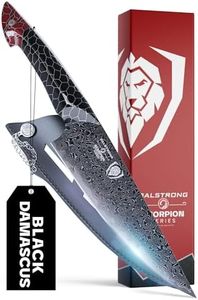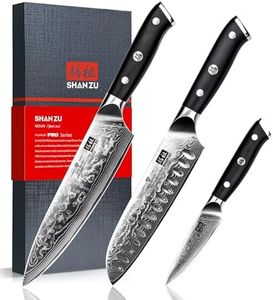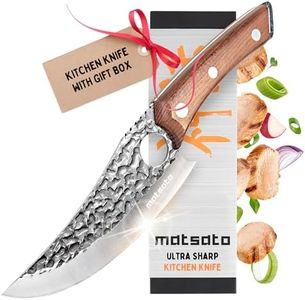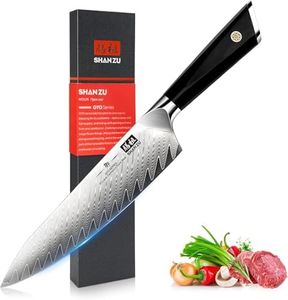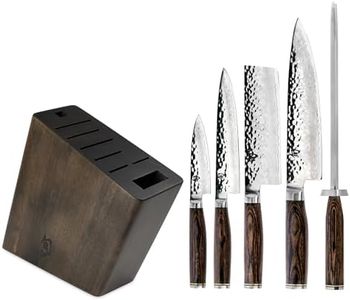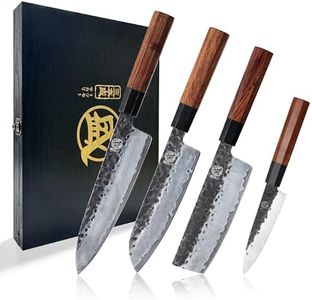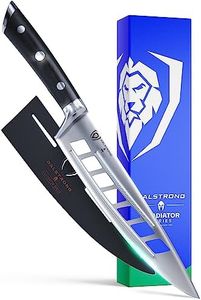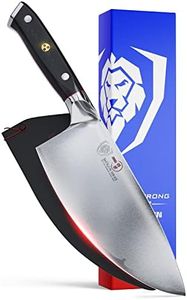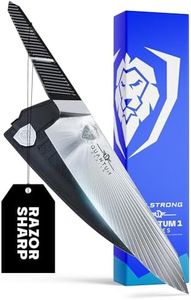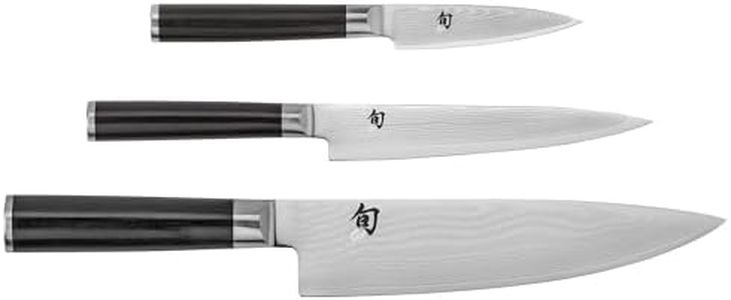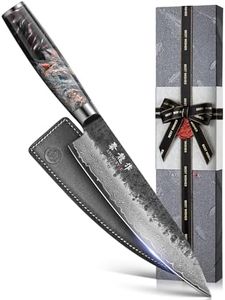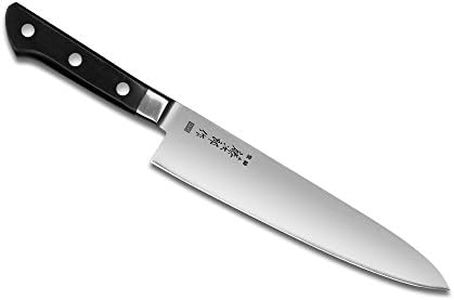10 Best Japanese Chef Knives 2025 in the United States
Our technology thoroughly searches through the online shopping world, reviewing hundreds of sites. We then process and analyze this information, updating in real-time to bring you the latest top-rated products. This way, you always get the best and most current options available.

Our Top Picks
Winner
SHAN ZU Damascus Knife Set, Japanese Super Steel 3 PCS Damascus High Carbon Professional Ultra-Sharp Kitchen Chef Knife Set with G10 Handle Gift Box
Most important from
4678 reviews
The SHAN ZU Damascus Knife Set features an 8-inch blade made from high-carbon Japanese 10Cr15Mov steel, known for its excellent hardness (62 HRC), rust resistance, and durability. The blade is forged with 67 layers of Damascus steel, giving it a beautiful natural pattern and added toughness. Unlike many knives that only have a laser-etched design, this knife’s Damascus pattern results from real folding and forging, which is a sign of quality craftsmanship. The plain edge is ultra-sharp, making it well-suited for precise slicing, dicing, and chopping tasks typical in Japanese cooking.
The handle is made from G10 glass fiber, which offers a comfortable, secure grip and is more durable than traditional wood handles. With a weight of 2.31 pounds, the knife balances well in hand, making it efficient for extended use without tiring the wrist. However, it’s not dishwasher safe, so hand washing is recommended to maintain the blade’s sharpness and handle integrity.
This set is ideal for home cooks or professional chefs who want a stylish, reliable knife that combines traditional Japanese steel qualities with modern materials for comfort and longevity. The lifetime promise from SHAN ZU adds confidence in its durability and customer support. On the downside, the knife might feel a bit heavy for those used to lighter Japanese knives, and the lack of dishwasher safety means some extra care is needed. Still, this knife stands out for its sharpness, strong construction, and attractive Damascus design, making it a solid choice for anyone serious about their kitchen tools.
Most important from
4678 reviews
Matsato Chef Knife - Perfect Kitchen Knive for Cooking, Chopping. Japanese Steel Knife for Home, BBQ. For Balance & Control, 6.3 Inch
Most important from
6524 reviews
The Matsato Chef Knife is a versatile tool designed for both home cooks and professional chefs. Made from high-quality stainless steel, its blade is durable and sharp, promising not to dull or chip easily. The knife features a 6.2-inch blade that is suitable for various kitchen tasks, from chopping vegetables to slicing meats. Its solid oak handle ensures a firm grip and balanced control, making cutting safer and more comfortable.
However, while the handle's material adds to the knife's quality, it may require extra care to maintain its condition over time since it is not dishwasher-safe. Weighing 6.2 ounces, the knife is lightweight, which can be a plus for prolonged use but might feel less substantial to those who prefer heavier knives. The Matsato Chef Knife's traditional Japanese craftsmanship combined with modern techniques makes it a reliable kitchen tool, also applicable for outdoor activities like camping and BBQs.
With a blend of durability, balance, and versatility, the Matsato Chef Knife is a strong contender in its category, though it requires careful hand washing to maintain its performance and appearance.
Most important from
6524 reviews
SHAN ZU Damascus Chef Knife 8 inch, 67-Layer High Carbon Steel Kitchen Knife Ultra Sharp Japanese Chef Knives, Professional Kitchen Utility Knives with G10 Ergonomic Handle/Gift Box
Most important from
1809 reviews
The SHAN ZU Damascus Chef Knife is an 8-inch kitchen knife crafted with a 67-layer Damascus steel blade featuring a strong Japanese steel core (10Cr15CoMoV). This layered forging process not only gives it a striking, wavy pattern but also enhances its durability, corrosion resistance, and sharpness. The blade has a 15° V-shaped edge on both sides, making it highly efficient for slicing and chopping a variety of foods like meat, vegetables, and fish. Its plain edge is versatile and easy to maintain, although it requires care to keep its sharpness over time.
The handle is made from G10 fiberglass, offering a comfortable, ergonomic grip that reduces fatigue during extended use and provides good balance with the blade. This handle material is more durable and moisture-resistant than traditional wood, making it suitable for busy kitchens. Weighing just over half a pound, the knife feels well-balanced and nimble, ideal for precise cutting tasks. The knife is also dishwasher safe, though hand washing is recommended to preserve its blade and handle quality.
While the knife is very sharp and durable, its high hardness (62 HRC) means it might be slightly more prone to chipping if used improperly, so some care during use is advised. Supported by a 24-month warranty, this knife is suitable for both home cooks and those seeking a professional-level Japanese-style chef knife without a steep price. It is a solid choice for those who value sharpness, visual appeal, and ergonomic comfort in their kitchen tools.
